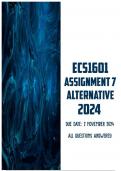, PLEASE USE THIS DOCUMENT AS A GUIDE TO ANSWER YOUR ASSIGNMENT
Please note that the author of this document will not responsibility for any plagiarizing you
commit.
Question 1
1.1. Suppose you live in South Africa and have the option to buy proudly South African
products or international brands. With reference to the circular flow of goods and services and
the circular flow of income and spending between households, firms, government and the foreign
sector, provide an explanation as to why it is better to purchase the proudly South African
products and also explain the opportunity costs of buying international items instead of those
produced locally.
Buying Proudly South African products is better because it keeps money circulating within the South
African economy. When local products are purchased, income flows back to South African firms,
which pay wages and invest locally, creating jobs and economic growth. Buying international goods,
however, causes a leakage in this circular flow, as money leaves South Africa, benefiting foreign
economies. The opportunity cost of buying international products includes the loss of potential
benefits from supporting local businesses, job creation, and reduced reliance on imports, which
would strengthen South Africa’s economy and provide long-term benefits to local communities.
Question 2
2. The following question is based on the passage below:
Mauritius’ economy has proven otherwise resilient to global economic shocks, including those
stemming from the war in Ukraine, which has affected revenues from tourism arrivals. GDP growth
rebounded by a relatively modest 3.5% in 2021 and accelerated to an estimated 8.3% in 2022,
supported by a strong recovery in tourism despite headwinds from the war in Ukraine. GDP growth is
projected to moderate to around 5.0% in 2023 as economic activities gradually return to normal.
2.1. With the aid of a diagram, explain how the money market in Maurituius will be affected by
the country’s change in economic growth in 2023. The direction of any changes should be clearly
indicated by using arrows.
In 2023, as Mauritius's economic growth moderates from 8.3% to an estimated 5.0%, demand for
money in the money market is likely to decrease, as economic activity stabilizes and individuals and
firms reduce transaction-related cash holdings. This lower demand shifts the money demand curve
(L) leftward to L’. Consequently, the equilibrium interest rate (i) decreases to i’, as shown by the
downward arrow on the vertical axis, indicating a decrease in the cost of borrowing. The money
supply (M<sub>s</sub>) remains unchanged as it is fixed by the central bank in the short run.





